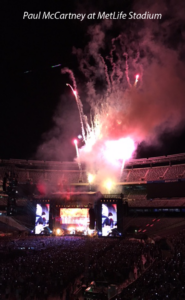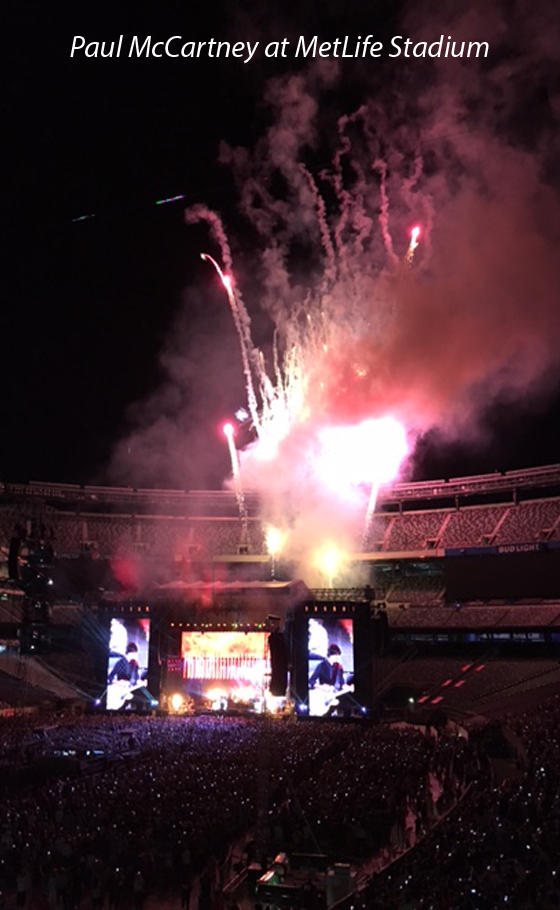
Paul McCartney gave an amazing concert at MetLife Stadium last night. Performing a 2 hour and 45 minute stadium show is an endurance test by itself, but the 74 year-old forever-Beatle pulled it off with the energy and enthusiasm of a 20 year-old. He and his excellent band played a mix of old and new songs and never went on “auto pilot.” There was a poignant moment when McCartney lingered on stage after the show was over. Although the band had already left the stage and many in the audience were heading for the exits, Sir Paul went to a mic and in a conversational tone of voice, thanked everyone for coming to the concert and saying how much he enjoyed performing for us. He didn’t speak for very long, but even so, it was far longer than he “had to.” I felt that he simply didn’t want to leave the stage. Like all of us when we’re doing something we love, he wanted to make it “last a little longer.” So Sir Paul is human like the rest of us. Who knew!!??
While watching the concert, I observed 5 things McCartney did that many jazz musicians can learn from. Here they are:
1. Say “thank you” as the audience applauds after you play a song.
Sure, Miles Davis could get away with ignoring an audience. But for the rest of us, if you ignore your fans, at some point they’ll start ignoring you. (BTW, the “thank you” doesn’t always need to be verbal. Even a nod or a smile can go a long way.)
2. When you play a tune the audience is unfamiliar with, follow it up with something they know and like.
This isn’t “dumbing it down.” On the contrary, it’s part of establishing a real connection with your audience. I saw this at the highest level of jazz when I was Gerry Mulligan’s assistant. Gerry played a lot of original compositions that most of the audience had never heard before. When he played a standard tune, however, he made sure it was a “biggie,” such as Duke Ellington’s “Satin Doll.” When you give the audience something they want, they’ll be much more accepting of your newer stuff.
3. Tell stories.
When you introduce a tune with a story, it’s a great way to “bring the audience in” and get them excited about what you’re about to play. Last night, Paul told stories about how some songs were composed and shared interesting experiences he’s had while performing others. This works with jazz, too. When I play a tune by composer/pianist John Lewis, for example, I tell a story about what happened when I led the dance band at his son’s wedding. When I play “Solitude,” I tell a story I read about how Ellington composed the song by holding the music paper up against the glass wall of the recording studio. The fun amazing part of this account is that he composed a song about being alone, while his 16-piece jazz band played the whole time! By the time I finish telling the story, the audience is totally quiet, focused, and ready to listen attentively to my piano playing.
4. Play music with contrasting moods.
All too often, jazz musicians play a whole set of material that basically sound the same. If the first song is high energy bebop, that’s all the audience will hear for the next 45 minutes. But even beboppers like Charlie Parker would mix up not only tempos but levels of lyricism. They’d follow a lightning fast and aggressive “Ko Ko” with a playful, medium tempo “Dewey Square. Then they’d throw in a pop tune of the era like “Slow Boat To China” (see #2 above).
5. Be intimate.
Play and speak from your heart and don’t be afraid to bare your soul. Paul McCartney did both, as does Keith Jarrett.
Put these 5 practices into action and watch your audiences respond positively to you and your music. You don’t have to copy anyone else’s style or approach, but find a way to view your performances as a way to enjoy your relationship with the audience. Yes, the music may be the most important thing to you, and learning from Paul McCartney in this regard will help your audience love your music as much as you do!
Take your left hand playing to a new level with my free ebook: Left Hand Techniques for Jazz Piano
You’ll also get my weekly jazz newsletter with practice tips and inspiration

